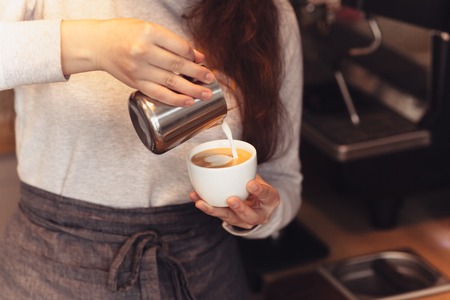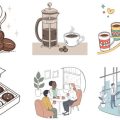Introduction to the British Coffee Culture
In recent years, the British coffee scene has undergone a remarkable transformation, evolving from its tea-centric traditions to embrace a vibrant and sophisticated coffee culture. Historically, tea has been the beverage of choice across the UK, with afternoon tea service serving as an iconic symbol of British hospitality and refinement. However, the landscape is shifting as coffee gains prominence both in casual settings and within the realm of fine dining. This evolution is not simply about adopting global coffee trends; it is also about integrating them into the unique tapestry of British social rituals. Today’s British coffee service draws upon centuries-old customs while introducing new elements of craftsmanship, presentation, and sensory appreciation. As cafes and restaurants across the country innovate their offerings, there is a growing emphasis on elevating coffee presentation to match the standards long set by traditional tea service. This cultural shift reflects a broader curiosity among consumers for quality, provenance, and experience—positioning coffee as an essential component of modern British hospitality.
2. The Art of Coffee Presentation
In the British coffee scene, the art of presentation is regarded as much more than a superficial flourish; it is an essential component of the overall experience. Professional coffee presentation in Britain seamlessly combines design, aroma, and visual appeal, each element tailored to meet the high expectations and refined tastes of British consumers. Understanding these key elements not only enhances the enjoyment but also reinforces the quality and authenticity of the service.
Design: Harmonising Tradition and Modernity
The design aspect of coffee presentation in Britain strikes a careful balance between classic elegance and contemporary flair. From the choice of crockery—often favouring fine bone china or minimalist ceramics—to the arrangement of accompanying biscuits or chocolates, every detail is considered. Baristas are trained to present beverages with clean lines and uncluttered aesthetics, respecting both heritage and modern trends.
Essential Design Elements in British Coffee Service
| Element | Description |
|---|---|
| Crockery Selection | Fine bone china for traditional settings, or matte ceramics for a modern touch |
| Table Setting | Neatly folded napkins, polished cutlery, and coordinated trays |
| Accompaniments | Biscuit or chocolate placed at a precise angle, sugar served in elegant holders |
| Latte Art | Classic rosettas or hearts, always symmetrical and visually striking |
Aroma: Inviting the Senses
The olfactory experience is paramount in British coffee culture. A well-presented cup should greet guests with inviting aromas that hint at the bean’s origin and roast profile. Establishments often highlight floral or nutty notes in lighter roasts or deep chocolate undertones in darker blends, aligning these aromatic cues with British preferences for subtlety and sophistication.
Techniques for Enhancing Aroma
- Serving immediately after brewing to capture peak freshness
- Using open cups to allow aromas to diffuse naturally
- Selecting beans with flavour profiles popular among British clientele (e.g., Ethiopian for floral notes or Brazilian for nutty sweetness)
Visual Appeal: Attention to Detail
The visual aspect extends beyond latte art; it encompasses everything from the cleanliness of the workspace to the alignment of cups on a tray. In Britain, understated elegance is preferred over ostentation, with attention paid to symmetry, colour contrast between crema and milk foam, and even spacing on serving platters. These details collectively contribute to an elevated perception of quality and care.
Summary Table: Key Elements of British Coffee Presentation
| Aspect | Application in Service |
|---|---|
| Design | Crockery choice, table setting, accompaniments arrangement, latte art precision |
| Aroma | Freshness timing, cup shape, bean selection according to local preferences |
| Visual Appeal | Workspace tidiness, symmetry in presentation, colour harmony between beverage components |
This holistic approach to coffee presentation ensures that every aspect—from visual charm to aromatic intrigue—meets the nuanced expectations of British patrons, ultimately elevating their entire coffee service experience.

3. Elevating Customer Experience
Delivering an exceptional coffee service within the UK context requires a nuanced understanding of local expectations and the art of personalisation. To truly elevate the customer experience, baristas and café managers must go beyond serving quality coffee—they must curate each interaction with consideration for British sensibilities, from understated hospitality to a warm, welcoming atmosphere. The journey begins with bespoke service standards: greeting guests promptly with genuine courtesy, using polite and familiar language, and demonstrating attentiveness without being intrusive. British customers often value efficiency paired with friendliness, so maintaining a brisk yet relaxed pace is key.
Understanding local preferences plays a pivotal role in shaping memorable experiences. This includes offering traditional favourites such as flat whites or filter coffees alongside more adventurous single-origin options, thereby catering to both classic tastes and growing trends. Anticipating guest needs—be it offering oat milk alternatives or recognising when a quiet corner is preferred—demonstrates a mastery of service that feels both personal and intuitive. Consistency in presentation, from latte art to well-timed table service, further reinforces the commitment to quality that British patrons expect.
Ultimately, enhancing the guest’s journey in a British coffee setting is about fostering a sense of belonging and familiarity while delighting customers with thoughtful touches. By integrating local customs, respecting individual preferences, and upholding high standards of professionalism at every touchpoint, establishments can transform routine visits into genuinely memorable moments—and set new benchmarks for coffee presentation across the UK.
4. Barista Skills: Beyond the Basics
Delivering a distinguished British coffee service requires baristas to master both technical precision and sensory finesse. The expectations for coffee quality in the UK have risen, with patrons seeking not only well-brewed beverages but also an engaging presentation that elevates their experience. In this context, baristas must go beyond routine tasks and embrace skills that blend artistry with scientific accuracy.
Technical Mastery: Extraction and Consistency
At the heart of exceptional coffee is precise extraction, where every variable—from grind size to water temperature—must be finely tuned. British consumers are increasingly discerning, demanding a consistent cup that reflects both the origin of the beans and the intention of the roaster. Achieving this level of consistency requires baristas to understand extraction theory and apply it practically during service.
| Extraction Variable | Impact on Flavour | Best Practices |
|---|---|---|
| Grind Size | Affects extraction rate; finer grinds yield stronger, sometimes bitter notes; coarser grinds result in lighter, sometimes sour profiles. | Adjust based on brew method and bean characteristics; calibrate regularly. |
| Water Temperature | Too hot extracts bitterness; too cool leads to underdeveloped flavours. | Maintain 92-96°C for espresso; use filtered water for clarity. |
| Tamping Pressure | Inconsistent tamping causes channeling and uneven extraction. | Apply even pressure (around 15-20kg) each shot; check equipment calibration. |
Sensory Skills: Artistry in Every Cup
Sensory skills distinguish outstanding baristas within the British café scene. A refined palate enables baristas to identify nuances in acidity, sweetness, body, and aftertaste—key for recommending blends or single origins suited to local tastes. Moreover, latte art has become a hallmark of quality coffee service in the UK, combining visual appeal with textural excellence. The ability to pour intricate patterns such as hearts, rosettas, or tulips signals both competence and care in preparation.
Key Sensory Competencies for British Coffee Service:
- Cupping: Regularly taste new arrivals to understand flavour profiles and guide customer recommendations.
- Milk Texturing: Achieve microfoam with a velvety mouthfeel suitable for flat whites—a British favourite.
- Aroma Assessment: Evaluate freshness and roast development by smell prior to brewing.
- Latte Art Execution: Consistently create visually pleasing designs as part of the customer experience.
The British Standard: Professionalism Meets Hospitality
The modern British barista is more than a technician—they are an ambassador for specialty coffee culture. Continuous training in both technical methods and sensory evaluation ensures that every cup reflects the high standards expected by UK coffee enthusiasts. By mastering these advanced skills, baristas contribute directly to elevating the British coffee service experience, marrying tradition with innovation on every tray delivered.
5. Coffee Pairings with Classic British Fare
In the quest to elevate the British coffee service experience, thoughtful coffee pairings with iconic British fare play a pivotal role in creating memorable moments for guests. The art of matching speciality coffee with beloved baked goods and savoury treats not only celebrates local culinary heritage but also highlights the nuanced flavour profiles of expertly roasted beans.
Elevating Afternoon Tea Traditions
The traditional afternoon tea, an enduring symbol of British hospitality, offers an ideal platform for coffee pairings. Instead of the conventional cup of tea, consider serving a delicate single-origin filter coffee alongside scones with clotted cream and strawberry jam. The gentle acidity and floral notes of an Ethiopian Yirgacheffe, for example, can cut through the richness of the cream while amplifying the fruitiness of the preserve.
Savouries Meet Speciality Coffee
Coffee’s complex flavour spectrum is equally at home with savoury classics. A full-bodied Colombian or Sumatran brew pairs beautifully with a warm sausage roll or a slice of mature cheddar-topped Welsh rarebit. The deep cocoa undertones and subtle spice in these coffees complement the umami and saltiness of traditional British savouries, enhancing both the drink and dish.
Sweet Treats and Coffee Nuances
From buttery Bakewell tarts to sticky toffee pudding, Britain’s sweet offerings are legendary. When paired thoughtfully, a bright Kenyan AA can enliven almond and cherry notes in a tart, while a mellow Brazilian roast might highlight the caramelised depth of sticky toffee pudding. By considering both texture and flavour, each pairing becomes a celebration of craft—both in baking and in brewing.
Crafting Experiences Through Local Connection
Ultimately, integrating speciality coffee into classic British fare is about more than just taste—it’s about crafting experiences that resonate with guests’ cultural expectations while introducing them to new sensory dimensions. Whether in a bustling London café or a cosy countryside tearoom, these carefully curated pairings invite guests to rediscover familiar favourites through the refined lens of modern coffee presentation.
6. Sustainability and Ethical Sourcing
In today’s British coffee landscape, sustainability and ethical sourcing have become fundamental pillars of a quality coffee service. Modern UK consumers are increasingly discerning, seeking not only a superior cup but also assurance that their coffee is produced with respect for people and planet. Coffee establishments across Britain are responding by placing sustainable practices at the heart of their operations, from bean to cup.
Highlighting the origins of beans is now more than a marketing point—it’s an ethical commitment. Responsible sourcing means working closely with trusted importers or directly with producers who uphold fair wages, safe working conditions, and environmentally sound farming methods. Many British cafés and roasteries showcase their relationships with Rainforest Alliance Certified or Fairtrade farms, providing transparency that resonates with local values of fairness and stewardship.
Operational sustainability also extends to daily practices within the café environment. Across the UK, baristas and operators are implementing measures such as compostable packaging, energy-efficient equipment, and comprehensive recycling schemes. These efforts not only reduce environmental impact but also elevate the entire coffee service experience, reflecting a conscientious approach that customers increasingly expect.
The movement towards sustainability is further championed by educational initiatives—staff training on waste reduction, customer engagement around reusable cups, and menu choices that minimise food waste. By making sustainable choices visible and accessible, British coffee businesses empower patrons to participate in positive change while enjoying their favourite brew.
Ultimately, prioritising sustainability and ethical sourcing sets a new standard for coffee presentation in the UK. It transforms each cup into a symbol of collective responsibility—showcasing not just technical excellence in brewing and serving, but a deep-rooted respect for global communities and local environments alike. This holistic approach is essential for elevating the British coffee service experience to meet both contemporary expectations and future challenges.


